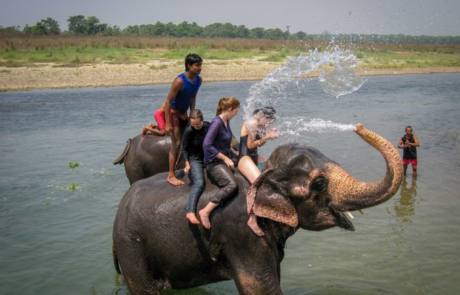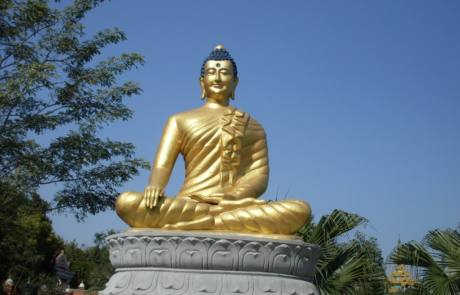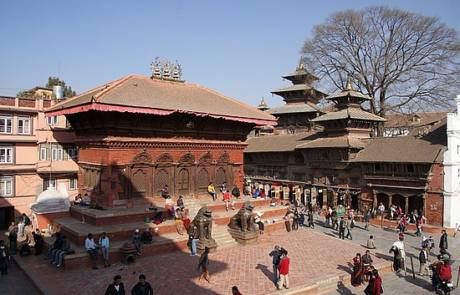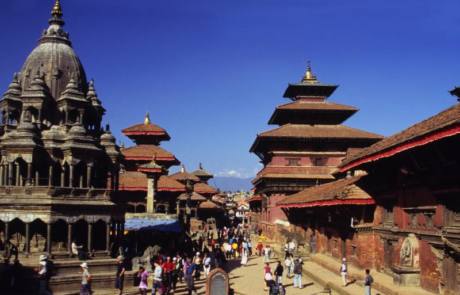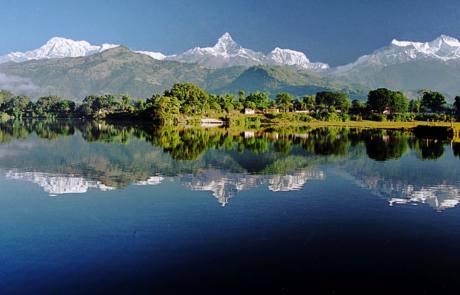8 DAYS/7 NIGHTS
KATHMANDU POKHARA MUKTINATH DARSHAN
Itinerary Summary
Muktinath : Mukti (Salvation) holds grate significance for all spiritual people in the south Asian sub continent. Muktinath (the provider of salvation) has been one such holy site, where thousands of devotees flock for attaining the much sought after moksha.
The famous temple of Lord Muktinath lies in the district of Mustang and is situated about 18 kms northeast of Jomsom in the north central part of Nepal, at an altitude of about 3800 meters from the sea level. Named after highly referred Muktinath shrine the valley is one of religious place in Nepal for both Hindus and Buddhist. Hindus call it Muktichhetra (Place of salvation) is one of the four religious sites. Many Shaligrams found here are considered by Hindu as incarnation of lord Vishnu and worship them. According to Hindu Myth lord Vishnu turned into Shaigram because of Brinda’s Curse. Similarly Buddhist calls this valley the Chumig Gyatsa ( place of 108 waterspouts). It is believed that Guru Rimpoche (Padmasambha) the scholar founder of Tibetan Buddhism once meditated and gained lifetime achievement of spiritual knowledge here while on his way to Tibet on 12 th century.. This place is opened through out the year but especially in Rishitarpani, Ram Nawami, and Bijay Dashami thousands of pilgrims gather here to celebrate the festival.
There are two ways to get to Muktinath from either take a flight from Pokhara to Jomsom and from Jomsom or trek all the way from Pokhara through Kali-Gandaki valley, which takes 7/8 days. It is believed that one should visit this temple after competing pilgrimage of four special religious sites in India . This temple held sacred by Hindus as well as Buddhists. The Jwala Mai temple nearby contains a spring and an eternal flame fed by natural gas underground. Jomsom is a major center in the Annapurna region.
Pre-departure planning is important.
Here are certain things you should watch for and plan for.
Visas
Check with the appropriate consulate or embassy in your country to find out if you will need a visa to visit the country of your destination, especially for an extended period of time. Some countries have extremely detailed and complicated entry/departure laws, and treat visits of a week or two very differently from longer stays.
Money
If you’re traveling to one area, check the cost of living there. If it’s high you’ll probably want to budget more carefully and save some money before leaving. The lower the cost of living the less you’ll have to save, but be sure to have a back up reserve in emergency cases.
General Tips
Talk to other people who have done a similar trip.
If you don’t know anyone personally, try any of the dozens of online travel web sites full of first-person travel stories covering every possible type of trip.
Plan big and loose. Read everything you can about the area.
There may be sights and attractions you didn’t know about. A rough outline of your trip might have three or four target points and a variety of ways to get between them.
You don’t want to find out that the weather isn’t what you thought, or the guide book was incorrect, after committing to 6 weeks in a specific spot.
Some trips will allow you more leeway than others. Travel plans in Asia can often be made day-by-day while summer travel in Europe should be organized at least a few weeks ahead, unless you’re prepared to hunt around for hotel rooms and train seats.
Set up a pre-trip time-line so you don’t end up with a full todo list your last week of work or school.
Things to consider are doctor’s visits for a check up, inoculations, and prescription refills; purchasing plane tickets; renewing passports and obtaining visas and other documents.
Check your insurance coverage abroad and purchasing additional travel insurance if needed. Don’t forget visiting friends and family members!
The longer the trip, the lighter you should pack. This might seem strange, but it’s true you can afford to lug a heavy bag around for a week or two, but do you want to have anything extra for a year?
Stick to the absolute basics and know what you can and cannot buy at your destination(s). There’s no point in bringing 6 months of toothpaste to Europe or buying a sarong at home to take to the tropics. If you are visiting several climates, try to arrange it so you visit the warmer places first and coldest last. That way you can purchase sweaters and long pants and not have to carry them any more than needed. Alternately, visit cold climates first and then ship unneeded layers home — or sell them off.
A good rule of thumb is to bring one outfit for the hottest day you’re likely to encounter, one for an average day, and one for the coldest.
Make sure everything goes with everything else (if that’s important to you), and remember that layers are always best.
Be prepared for uncomfortable trips. You will often find yourself in a busy, cramped, economy class environment and it could be for many hours – especially long plane trips.
If you want to arrive at your destination refreshed and able to enjoy the sights, then try a good quality travel pillow to support your head, some ear plugs to block out the screaming babies, and an eye cover to block out the sun or cabin lights.
Just avoid those cheap U-shaped pillows from airport shops – your head drops forward and you wake up with a stiff neck.
Make contact with the locals before you go.
Maybe you have a friend-of-a-friend or a foreign exchange student from high school you remember, or just found a friend through a travel web site; almost everyone is happy to welcome a foreign visitor to their home town. This might be as elaborate as a home-stay for a few weeks, or just coffee in their home town or dinner at a locals restaurant.
Trip Attractions
Visit Manokamana Devi Temple.
Pooja & Darshan of Muktinath at Muktinath Temple.
Travel Resources
Travel planning is about more than just knowing where you’re going. Prepares to navigate, take control and be ready for anything. This section helps you steer clear of disaster and stay open enjoy the unexpected.
Quick Tips
- Banks – Open Monday to Friday 9am to 2pm. Some banks are closed for lunch.
- Emergencies – For police, dial a local phone number; for ambulance call a hospital.
- Internet Access – Wifi is standard in most hotels and free in many coffee shops.
- Mail – Buy stamps at the Post Office. Convenient post offices are located all cities. Most are open Monday to Friday 9am to 3pm.
- Safety – Pickpocketing can be a common problem. It is suggested for men to keep wallets in their front pocket. Purse snatching also occurs at times.
Visitor Information
This site contains information with a very personal and friendly structure. It also has great links to other related sites online.
Information, internet access, maps, and train passes are available at local Tourist Information terminals. These are located at various sites around the city. Expect a wait if you arrive late in the afternoon or during lunch time. Local travel agencies are also helpful for quick information and finding hotels. There is no service charge for these services. Hours are Monday to Friday 9am to 5pm, and Saturday 10am to 2pm.
Transportation
Getting in from the airport and other arrival locations. Travel planning is about more than just knowing where you’re going. Prepares to navigate, take control and be ready for anything. This section helps you steer clear of disaster and stay open enjoy the unexpected.
- Plane – Flights arrive at the main airport near city center. If flying from European cities, you might land at a connecting airport. There is a tourist information office at the Terminal E, international arrivals, open 8am to 6pm.
- Train – A train station is on the lower level of the airport. To get into the city, follow the marked signs.
- Taxi – From the airport there is a flat-rate for the 1-hour trip, depending on traffic. Hotels charge up to $80 for shuttle service.
- Train & Bus – Trains and buses arrive a city center. This is the transportation hub for the city and is surrounded hotels.
A perfect place for exploring on foot, with local shops around every corner. You will eventually walk somewhere, it’s just going to happen. If you don’t like crowds, uneven cobblestones, heavy traffic or narrow sidewalks, take a taxi or rent a scooter.
Itinerary Details
Day 01 : Arrival in Kathmandu and transfer to the hotel. O/N at the hotel.
Day 02 : Drive to Pokhara via visit of Manokamana Devi temple by cable car. Arrival in Pokhara and transfer to the hotel. O/N at the hotel.
Day 03 : Fly to Jomsom. Arrival in Jomsom and drive to Muktinath by jeep (21 kms / 02 hrs drive). Pooja & Darshan of Muktinath and drive back to Jomsom and transfer to the hotel. O/N at the hotel.
Day 04 : Fly to Pokhara and transfer to the hotel. O/N at the hotel.
Day 05 :Sightseeing of Pokhara city. O/N at the hotel.
Day 06 : Fly back to Kathmandu and transfer to the hotel. O/N at the hotel.
Day 07 : Sightseeing of Kathmandu. O/N at the hotel.
Day 08 : Departure transfer to the airport.

